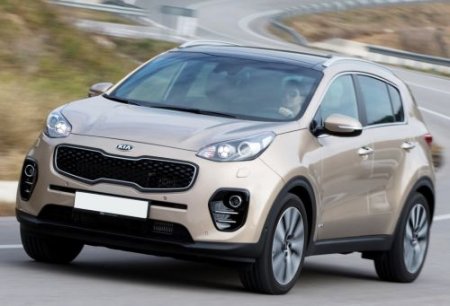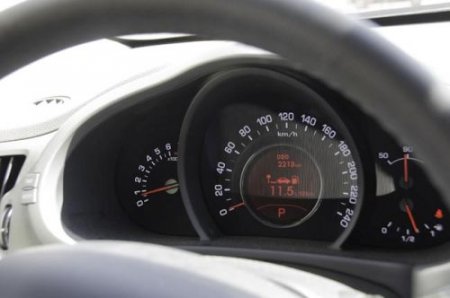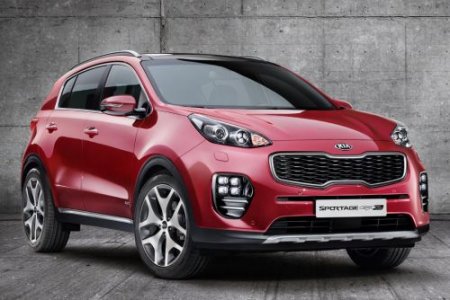
KIA Sportage in detail about fuel consumption
Content
Kia Sportage is a car that is very popular with our motorists. It is distinguished by its comfort and reliability, and the fuel consumption of the KIA Sportage per hundred kilometers is quite acceptable.

One of, probably, the most important indicators of the quality and comfort of a car, of course, is the fuel consumption indicator. After all, if the car is intended for family use, then the car with the lowest fuel consumption is given more preference.
| Engine | Consumption (track) | Consumption (city) | Consumption (mixed cycle) |
| 1.6 GDI (gasoline) | 5.6 l / 100 | 8.6l / 100 | 6.7 l / 100 |
| 2.0 NU 6-auto (petrol) | 6.1 l / 100 | 10.9 l / 100 | 6.9 l / 100 |
| 2.0 NU 6-auto 4x4 (petrol) | 6.2 l / 100 | 11.8 l / 100 | 8.4 l / 100 |
| 1.6 TGDI 7-auto (petrol) | 6.5 l / 100 | 9.2 l / 100 | 7.5 l / 100 |
| 1.7 CRDi 6-mech (diesel) | 4.2 l / 100 | 5.7 l / 100 | 4.7 l / 100 |
| 2.0 CRDi 6-automatic (diesel) | 5.3 l / 100 | 7.9 l / 100 | 6.3 l / 100 |
In the article, we will make a general overview of Kia models and compare the main indicators of fuel consumption per 100 km of run, find out how it will be possible to reduce fuel consumption.
Characteristics of models
Kia Sportage first appeared on the car market in 1993, it was released by Japanese automakers. It was, perhaps, one of the first crossovers, driving which you can feel comfortable both in the conditions of the city highway and on rough terrain.
In 2004, the Sportage 2 was released with a new modification and more comfortable for movement. It can be compared to a minivan in terms of roominess and an SUV in terms of dimensions and technical characteristics.
(quality of painting, ease of use of the salon and much more) and reviews are different.
And in 2016, the Kia Sportage model of a new modification was released, which differs from the previous version by a slight increase in size and external modification.
Advantages and disadvantages
Each Sportage model has its own advantages and disadvantages. Let's consider them below.

Model advantages
Of the large number of positive qualities of each model, the following can be distinguished:
- in Kia 2, the headlight glass was replaced with polycarbonate;
- the height inside the car has become comfortable for the driver and passengers;
- in Kia, 2 rear seat backs can be individually adjusted;
- independent suspension makes it easy to maneuver the car;
- pleasant design and beautiful external forms will make you feel comfortable not only for men, but also for women drivers;
- the volume of the luggage compartment of the 2016 Kia increased by 504 liters;
The positive aspects of the new 2016 model include the presence of a large set of safety systems for the driver and passengers. But, as it turned out, all add-ons can be purchased only after additional payment.
Disadvantages of Kia Sportage
- rear seating is a bit small for three adults in the Kia Sportage 2;
- the steering wheel is too large and unusually thin;
- the Sportage 3 crossover is intended mainly for movement on city roads, as an SUV it is not suitable;
- the Sportage 3 doors create a lot of noise even when closing smoothly;
- the body paint of the Kia 3 is of very poor quality and is highly susceptible to the slightest scratches, which quickly deteriorates the appearance;
- the tightness of the headlight housing is broken, which is why they tend to constantly fog up;

Fuel consumption for different models
Fuel consumption rates for KIA Sportage range from seven to twelve liters of gasoline and from 4 to 9 liters of diesel fuel per 100 kilometers. But, in various forums of motorists, data on fuel consumption are different. For some, they coincide with those stated in the technical documentation for the car, while for others they exceed the norm. For example, the consumption of gasoline in the city is significantly higher than the declared norms according to the reviews of members of car owners' clubs.
The consumption of KIA Sportage 3 within the urban highway ranges from 12 to 15 liters of fuel per 100 kilometerswhich is not very economical. The average gasoline consumption of a KIA Sportage 2 on the highway ranges from 6,5 to 8 liters of fuel per 100 kilometers, depending on the engine modification. Diesel fuel consumption is slightly higher - from seven to eight liters per hundred kilometers.
Fuel costs of the 2016 KIA Sportage depend on the type of engine - diesel or gasoline. If you have a car with a 132 hp gasoline engine, then with a mixed type of movement, fuel consumption will be 6,5 liters per 100 km, if the power is 177 hp, then this figure will increase to 7,5 liters. Fuel consumption for a KIA Sportage diesel engine with a capacity of 115 hp will be an average of 4,5 liters of diesel fuel with a capacity of 136 hp. - 5,0 liters, and with a power of 185 hp. the fuel indicator will increase to six liters per 100 kilometers.
The answer to the question, what is the real fuel consumption of the KIA Sportage, will always be ambiguous due to the large number of external factors that, to a greater or lesser extent, affect the consumption indicator.
KIA Sportage gasoline consumption per 100 km is affected by the quality of the roadway, the speed of cars in the general stream. For example, if you regularly get into traffic jams, then the fuel consumption during idling of the engine will increase. But, moving at a uniform speed, on an empty highway outside the city, fuel consumption indicators will correspond to the declared standards or will be as close as possible to them.

One comment
Take Dean
I drive a Kia Xceed 1.0 tgdi, 120 hp, 3 years old with 40.000 km.
Declared consumption has nothing to do with actual consumption.
Open road, plain 90 km/h, gas pedal 6 l, city 10 l, city peak over 11 l, highway up to 150 km/h 10 l. I would like to mention that the vehicle is properly maintained, the tires are always with the factory pressure and not with a heavy foot on the gas.
With a heavy foot on the gas, consumption increases by 2 to 3 l per 100 km.
A very nice car, but the fuel consumption is a disaster at the level of some racing cars, but this car is by no means like that.